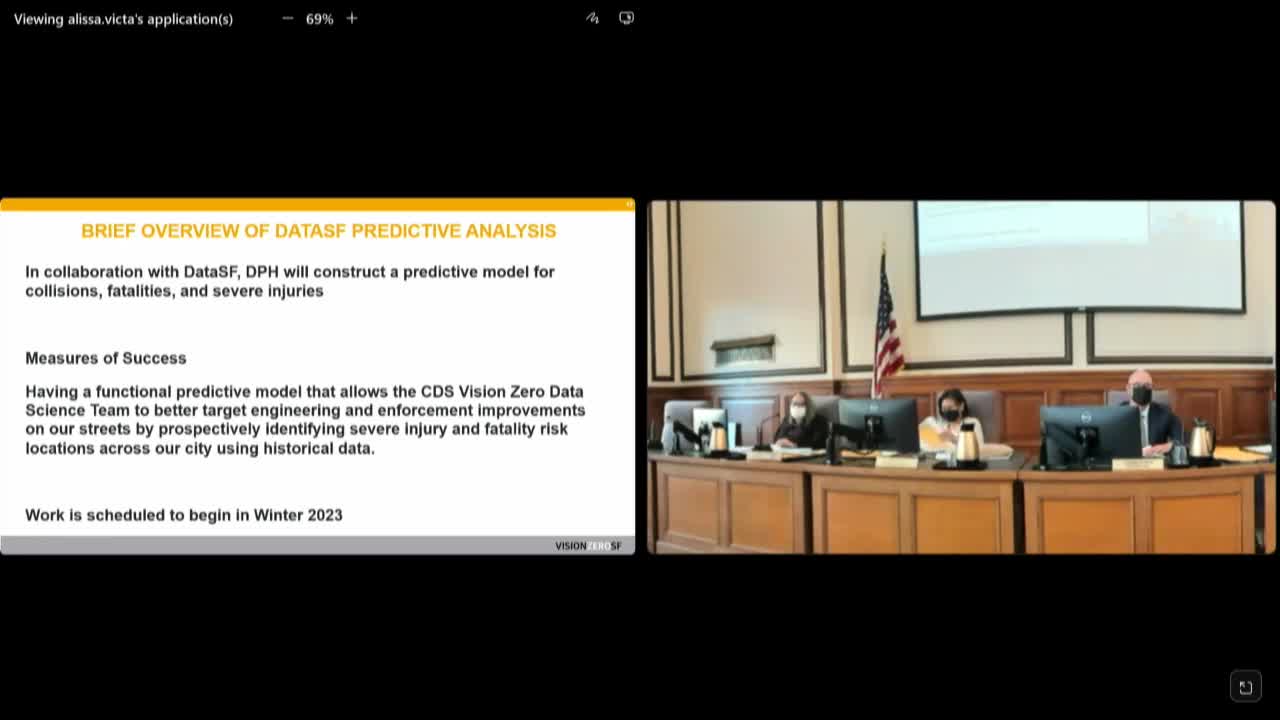SFMTA advances Vision Zero Action Strategy to reduce traffic fatalities in San Francisco
October 03, 2023 | San Francisco City, San Francisco County, California
This article was created by AI summarizing key points discussed. AI makes mistakes, so for full details and context, please refer to the video of the full meeting. Please report any errors so we can fix them. Report an error »

In the heart of San Francisco's bustling city hall, a pivotal discussion unfolded as Jamie Parks, overseeing the Livable Streets division at the San Francisco Municipal Transportation Agency (SFMTA), addressed the pressing issue of street safety. With a commitment to the Vision Zero initiative, which aims to eliminate traffic fatalities, Parks emphasized the collaborative efforts with the Department of Public Health (DPH) that have been ongoing since the program's inception in 2014.
Parks highlighted the Vision Zero Action Strategy, adopted in 2021, which outlines a comprehensive approach to achieving zero deaths on the streets. This strategy is not reliant on a single solution but rather a multifaceted approach that includes redesigning streets, implementing speed safety measures, and promoting sustainable transportation options. "There’s no single silver bullet," Parks stated, underscoring the need for a combination of interventions to effectively reduce traffic-related fatalities.
Among the key components discussed, Parks noted the importance of street redesigns, which can lead to a 30% reduction in crashes. He pointed out that while this is significant, it still leaves a substantial number of incidents unaddressed. To combat this, the SFMTA is focusing on slowing down vehicle speeds, with speeding identified as the leading cause of injuries and fatalities. The introduction of speed safety cameras is on the horizon, pending state approval, which could see up to 33 cameras deployed across the city.
Parks also addressed the critical need for a shift in transportation modes, advocating for increased use of public transit, biking, and walking. He acknowledged the challenges posed by larger, faster vehicles on the road and the necessity for stringent regulations on these vehicles. Furthermore, he connected the issue of traffic safety to the broader housing crisis, noting that individuals experiencing homelessness are disproportionately affected by traffic incidents.
As the meeting progressed, Parks detailed various initiatives aimed at enhancing pedestrian safety, including the installation of speed humps and raised crosswalks, with a goal of implementing at least 100 traffic calming measures annually. The SFMTA's quick build program, designed to expedite street improvements, has already shown promising results in reducing injuries.
Looking ahead, Parks announced plans for an updated bicycle plan, set to be presented in spring 2024, which aims to expand the city’s network of protected bike lanes. With nearly 50 miles of such lanes already established, the initiative reflects a growing commitment to making biking a safer and more appealing option for residents.
In closing, Parks acknowledged the long road ahead in achieving Vision Zero, emphasizing that this is not merely a ten-year commitment but a multi-decade endeavor. "We are committed to continuing the work as long as it takes to get there," he affirmed, leaving attendees with a sense of urgency and hope for a safer future on San Francisco's streets.
Parks highlighted the Vision Zero Action Strategy, adopted in 2021, which outlines a comprehensive approach to achieving zero deaths on the streets. This strategy is not reliant on a single solution but rather a multifaceted approach that includes redesigning streets, implementing speed safety measures, and promoting sustainable transportation options. "There’s no single silver bullet," Parks stated, underscoring the need for a combination of interventions to effectively reduce traffic-related fatalities.
Among the key components discussed, Parks noted the importance of street redesigns, which can lead to a 30% reduction in crashes. He pointed out that while this is significant, it still leaves a substantial number of incidents unaddressed. To combat this, the SFMTA is focusing on slowing down vehicle speeds, with speeding identified as the leading cause of injuries and fatalities. The introduction of speed safety cameras is on the horizon, pending state approval, which could see up to 33 cameras deployed across the city.
Parks also addressed the critical need for a shift in transportation modes, advocating for increased use of public transit, biking, and walking. He acknowledged the challenges posed by larger, faster vehicles on the road and the necessity for stringent regulations on these vehicles. Furthermore, he connected the issue of traffic safety to the broader housing crisis, noting that individuals experiencing homelessness are disproportionately affected by traffic incidents.
As the meeting progressed, Parks detailed various initiatives aimed at enhancing pedestrian safety, including the installation of speed humps and raised crosswalks, with a goal of implementing at least 100 traffic calming measures annually. The SFMTA's quick build program, designed to expedite street improvements, has already shown promising results in reducing injuries.
Looking ahead, Parks announced plans for an updated bicycle plan, set to be presented in spring 2024, which aims to expand the city’s network of protected bike lanes. With nearly 50 miles of such lanes already established, the initiative reflects a growing commitment to making biking a safer and more appealing option for residents.
In closing, Parks acknowledged the long road ahead in achieving Vision Zero, emphasizing that this is not merely a ten-year commitment but a multi-decade endeavor. "We are committed to continuing the work as long as it takes to get there," he affirmed, leaving attendees with a sense of urgency and hope for a safer future on San Francisco's streets.
View the Full Meeting & All Its Details
This article offers just a summary. Unlock complete video, transcripts, and insights as a Founder Member.
✓
Watch full, unedited meeting videos
✓
Search every word spoken in unlimited transcripts
✓
AI summaries & real-time alerts (all government levels)
✓
Permanent access to expanding government content
30-day money-back guarantee

